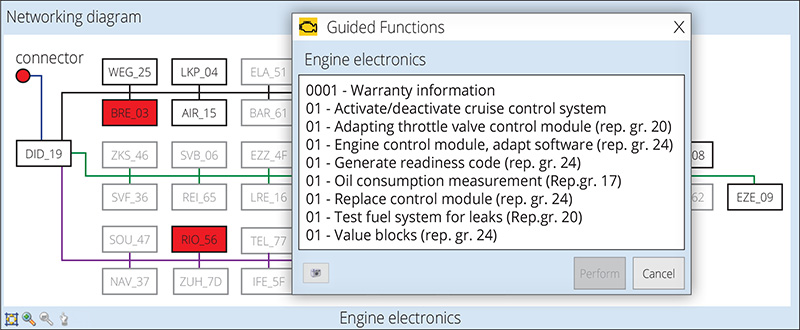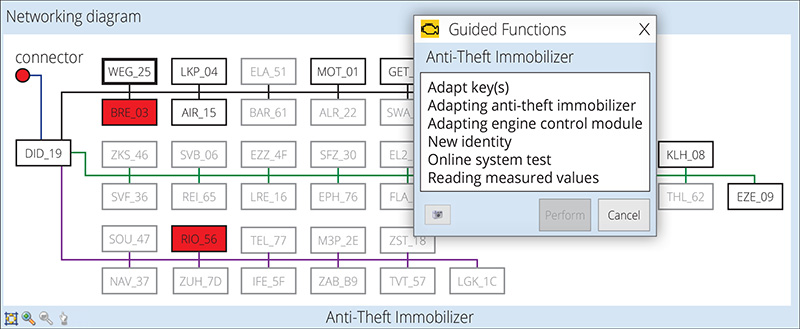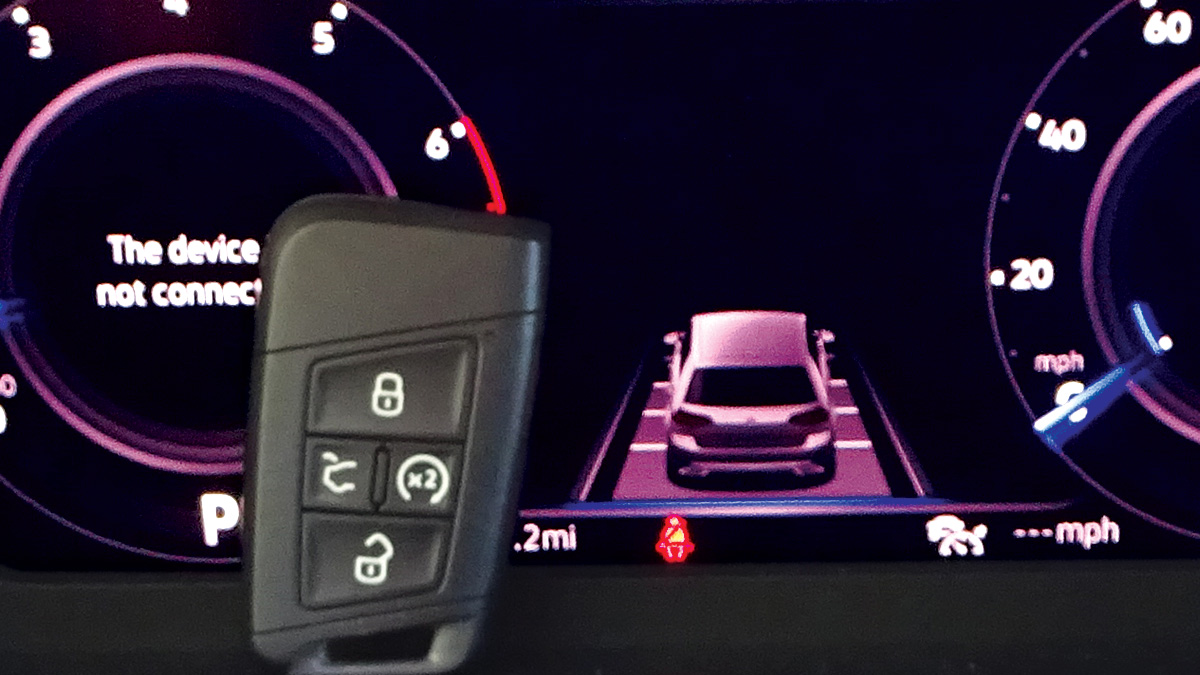Is it a GO or a NO-GO?… You Make the Call!
Diagnosing and Adapting VW/Audi’s Immobilizer can be Challenging.
Get One Step Wrong, and the V-Dub is Dead… Don’t be “That Guy.â€
VW and Audi introduced their immobilizer system (known as IMMO) in 1995 in the ROW (Rest of World) market. This system was Volkswagen’s original immobilizer system until 1999, but IMMO was not fitted on U.S. vehicles sold in the North American Region (NAR) between 1995 and 1999.
In 2000, VW introduced the next iteration of immobilizer, known as IMMO II. These vehicles were among the first with IMMO systems in the U.S. and North American Region. Almost every Volkswagen and Audi product since 2000 has had a version of IMMO on board.
Upon the release of IMMO II, by default, the original IMMO system became IMMO I. In 2021, we are now working with IMMO VI-equipped vehicles. There are some significant changes as IMMO I through V have morphed over time.
Here, we will attempt (in the space of an article) to provide as much actionable intelligence on these systems as possible; how the systems are configured, what pitfalls to avoid during service, and some tips on initializing, coding, and authorizing both the standard IMMO and the KESSY system, or Access-Start push button system.
VW/Audi IMMO is a deep subject and can be full of potential problematic service results if the directions and service info are not clearly followed. Because the deployment of the IMMO system over the years has been based on proliferation throughout all models, years, and countries, the first thing to realize about IMMO is that the actual version of the IMMO system on the vehicle in front of you is not standardized and tied to specific models and years, but more to the vehicle platforms and the country it will be sold in.
For this reason, you must first identify the proper IMMO system in order to get the coding, adaptations, and initialization setup correctly. There is rarely any margin for error with configuration and adaptation of these systems.
Failure to do this will usually result in a locked up or useless module, depending on the mistake. This is especially true if you are trying to replace a VW ECM, instrument cluster or lock cylinder (coil) with a used part.
This can be done of course, but it can be tricky to get right and, in many cases, coding a used part into a VW or Audi equipped with any IMMO variant requires careful steps to follow to avoid disaster in the bay.

The BIGGEST- LOUDEST piece of advice we can give you from our support line experience is to look up TSBs, tech tips, and service info every time you work on one of these systems, no matter the year and model. This one piece of advice can mitigate 90% of the nightmare calls we receive once the mistake is made.
How the IMMO works: Theory of Operation Overview
Throughout all versions of VW’s Immobilizer, the same basic theory of operation applies. The immobilizer, first and foremost, is not part of the alarm system, will not prevent the vehicle from cranking or starting (initially), nor is it directly tied to the starting system in any way. IMMO’s only job is to authorize the “proper†key.
The vehicle will start every time, but if Immobilizer doesn’t authorize the proper key, the engine is shut down within one second of run-time. If a VW/Audi vehicle starts and runs longer than one second, say it stalls after 5, 10 or more seconds of run-time, it is generally not the IMMO system that is causing the fault. IMMOs always shut the car down one second after engine start if the key is not authorized.
Immobilizer works with very low power radio signals (RFID). The RFID device resides in the key fob. However, the battery for the key fob does not power the RFID chip itself; the battery in the fob only powers the electronics for the car access functions.
The RFID chip is inductively powered and woken up, when the device (fob) is in close proximity (approximately one inch from the coil if mounted behind the plastic covers in the column, or up to max 3 inches if the coil is exposed) to the RFID coil assembly (D, D2), which provides the inductive RF voltage that makes the RFID chip work. (This is a common misconception regarding powering of the RFID.)
The ignition lock cylinder houses the RFID coil (D2), which is not serviced separately. When the RFID equipped key is inserted into the key cylinder, the inductive current from the coil induces the RFID transponder to send a radio signal back through the coil.
This signal is then decoded by the IMMO control module in the cluster and the ECM. When the RFID chip is recognized, the Immobilizer module sends a random code back to the key. The module and the key perform a verification via a matching calculation. When the proper key is recognized and authorized, the IMMO module sends the start authorization to the ECM. (See Figure 2 chart to the right for system differences.)
The entire process occurs within one second of engine start.
Now, with the basic theory out of the way, it is important to understand that the signal/auth pathway and components through which this RFID signal travels vary significantly, based on which variant system is on board.
For example, the IMMO IV system can be configured two ways: the IMMO IV Discharge (key based system) or the IMMO IV Adaptation (KESSY Access-Start Push Button system).
In both cases, the IMMO does the same tasks, but the components, signal pathway, and initialization and coding procedures are markedly different. Let’s try to summarize each iteration of the system and look at the differences that affect diagnostics, repairs, and service.
System Identification
IMMO systems have 5 “platform†versions. Within these 5 IMMO versions, there are 10 different configuration variants. For a great single page view of the topology, look up VWOA TSB #96-10-07TT dated Sept. 19, 2017. (See Figure 3 on page 5.)
There is a paragraph in this tech tip bulletin that is critical to successful servicing of all VW/Audi Immobilizer systems.
Advice from the Service section of Tech Tip 96-10-07TT:
“When performing any Immobilizer associated functions, it is important to determine the type of Immobilizer being worked on. This will ensure the correct test plan is selected whether adapting keys or replacing a major component of the Immobilizer system. See chart below to determine the exact system being used.â€
| Variants | Immobilizer Generation |
|---|---|
| 1 | Immobilizer II |
| 2 | Immobilizer II Gen 2 |
| 3 | Immobilizer II Gen 3 |
| 4 | Immobilizer III |
| 5 | Immobilizer IV with Adaption |
| 6 | Immobilizer IV with Adaption Access Start and ESCL |
| 7 | Immobilizer IV with Download |
| 8 | Immobilizer IV with Download and ESCL |
| 9 | Immobilizer IV with Download, Access Start and ESCL |
| GFF | Multiple system used either this model |
IMMO I: (Not in US Market) 1995-1999 (ROW)
This was the first iteration of VW’s Immobilizer system. It used a fixed-code transponder key (usually identified with an F stamped on the key shaft), the RFID inductive coil assembly, the IMMO Control Module and, of course, the ECM. This was a very basic early version of the immobilizer system.
IMMO II: 2000-2002 U.S. (NAR) and ROW Markets
IMMO II was a more electronically embedded immobilizer system. This version has the Immobilizer Control Module (J367) integrated into the (J285) Instrument Cluster assembly (not serviced separately).
Access module 17, Instruments at address 05 for the Immobilizer Control Module in the cluster.
| NOTE |
| Some Cabrio and Eurovan models equipped with IMMO II and III employed a stand-alone IMMO Control Module, which is NOT integrated into the J(J285) cluster. This module can be accessed by selecting immobilizer, address 25. |
There are 3 generations of IMMO II, Gen 1, Gen 2, and Gen 3 (not to be confused with IMMO III).
This system must be coded and initialized. The coding is done either in the IMMO module (within the cluster or external IMMO Control Module), or in the ECM, depending on the service operation you are performing. Therefore, performing correct system ID first, followed by careful execution of the steps found in service info for that make and model, will ensure a minimum of hiccups or failures.
| NOTE |
| A critical must when working on these systems of any era is to do a TSB and Tech Tip search. Almost ALL IMMO pitfalls and mistakes can be avoided if the technician locates and follows instructions in these tech tip bulletins. |
This article is scattered with examples of these TSB Tech Tips. Do your research and reading, and you can pretty much keep yourself out of ugly trouble on Immobilizer vehicles. Haste (and assumptions) make waste with these systems.
IMMO III: 2003-2006 (Some 2007 Models)
IMMO III variants throw another module into the immobilizer “verification calculation†process. As we learned with IMMO II, the Lock Set, Key, and Instrument Cluster (with the IMMO Module therein…) are in play for IMMO verification and start authorization.
Immobilizer III adds the ECM into the calculation and verification of the key. Other than that, there are only subtle technical differences between IMMO II and III.
IMMO IV: 2006 and Later
IMMO IV has two variants, and significant differences in configuration. For example, IMMO IV doesn’t utilize a dedicated Immobilizer Control Module in the cluster as in previous versions. Rather, the IMMO IV utilizes multiple module verification and authorization through adaptation modules and network messages.
IMMO IV also has two variants, The first is identified as IMMO IV Download, also known as IMMO IV Discharge.
The other variant is IMMO IV Adaptation. To identify which system you are working with, obtain TSB Tech Tip from VWOA, # 96-10-07TT dated Sept. 1, 2017 for complete information.
VWX in the serial number will indicate an IMMO IV Download System.
VWZ will indicate the IMMO IV Adaptation variant.
VWY serial number indicates a discharge system that has not been adapted. Some models incorporate a dozen or more network modules into the IMMO-KESSY-Component Protection scheme.
On these vehicles, it is extremely important to follow instructions to the letter, or you may end up with the dreaded “New Identity†problem… more on this dreaded disease shortly.

IMMO V: Immobilizer V, and MQB vehicles 2012+ and Certain 2009 and Up Equipped Vehicles
The MQB vehicle platforms and Immobilizer V vehicles are pretty much different systems altogether. While IMMO still seeks to verify and authorize the KESSY Key, this iteration utilizes multiple modules for verification, and ties into the Component Protection and Security scheme as well.
This platform can have up to a dozen or more modules involved in the adaptation and information stream, including, but not limited to, the TCM, HVAC, Radio-Amp, and other seemingly non-immobilizer related modules. Immobilizer V is typically accessed through component security and will either need an ODIS connection with an LSID technician operating it, or a visit to the local dealer.

Making The “New Identity†Mistakes: Don’t Be That Guy!
What do we mean by the “new Identity†nightmare?
Consider this scenario: A technician had been trying to code (or adapt) a used ECM into a VW vehicle. Rightfully thinking he needed to adapt the ECM to the Immobilizer, he went in through Engine Electronics and tried to adapt the used ECM to the car. When he commanded the adaptation, the used ECM wrote its original VIN to the vehicle’s IMMO module backwards. In other words, the VIN from whatever vehicle the used ECM was removed from, was now adapted to the customer’s car. Uh-oh.
This was game over. This type of error can create the need for replacement of the entire Immobilizer system, the Immobilizer Module/Cluster, the ECM, the Lock Cylinder, all of the door lock assemblies, and a few other pieces along the way. This is a huge mistake if made, as those of us who have ever made it well know.
If this happens on a late IMMO IV or IMMO V vehicle, it can be a devastatingly expensive mistake, due to the number of modules involved, not to mention the component security aspects. This is why independent techs working on these vehicles must search the TSBs, correctly identify the system, and adapt and code it properly.
The alternatives are simply too costly with these vehicles. There are many tricks and tips for working on these vehicles, such as TSB Tech Tips on how to wake up the CAN with Flash to Pass, Brake or Hazard Flasher operation and when this is not needed, when adapting a KESSY key to an immobilizer and losing the 15 signal.
For reference, see VWOA Tech Tip TSB #s 96-12-03TT – KESSY System Loss of 15 Power, TSB # 96-14-02TT – Immobilizer 4 (Download) – Adapting Keys after Vehicle Lock Set Replacement and TSB#57-21-01TT – MQB Vehicle, KESSY Key Adaptation, No Terminal 15 Ignition ON Status.
Look up those bulletins. Get the test plan right for the system in your bay. Don’t be “that guy.â€
Immobilizer Overview Summary
In terms of general direction in diagnosing no-start and other driveability on these vehicles, it is good to keep the following in mind:
Remember, no matter the version, the IMMO is not tied to the starter itself. So if we have a no-crank, no-start condition, it is not at all likely that the IMMO is causing the fault.
Second, IMMO is not a part of the theft alarm system either, so problems with car access functions are generally not the fault of IMMO either.
Third, remember that the fob battery (IMMOs 2-3) does not power the key’s RFID transponder.
And finally, it is important to know that the RFID key can only be coded and initialized once.
If you lose the keys, or for whatever reason need to replace the key cylinder and all the keys… do it right, or else. There is no coming back from getting it wrong with that new key, as it can only be written to one time.
No matter your immobilizer repair operation, your goal is to get that awesome success message shown in Figure 6!
These four issues are the most common points of confusion with fielding VW/Audi IMMO or no-start problems, commonly after there was a failure during coding or initialization.






0 Comments